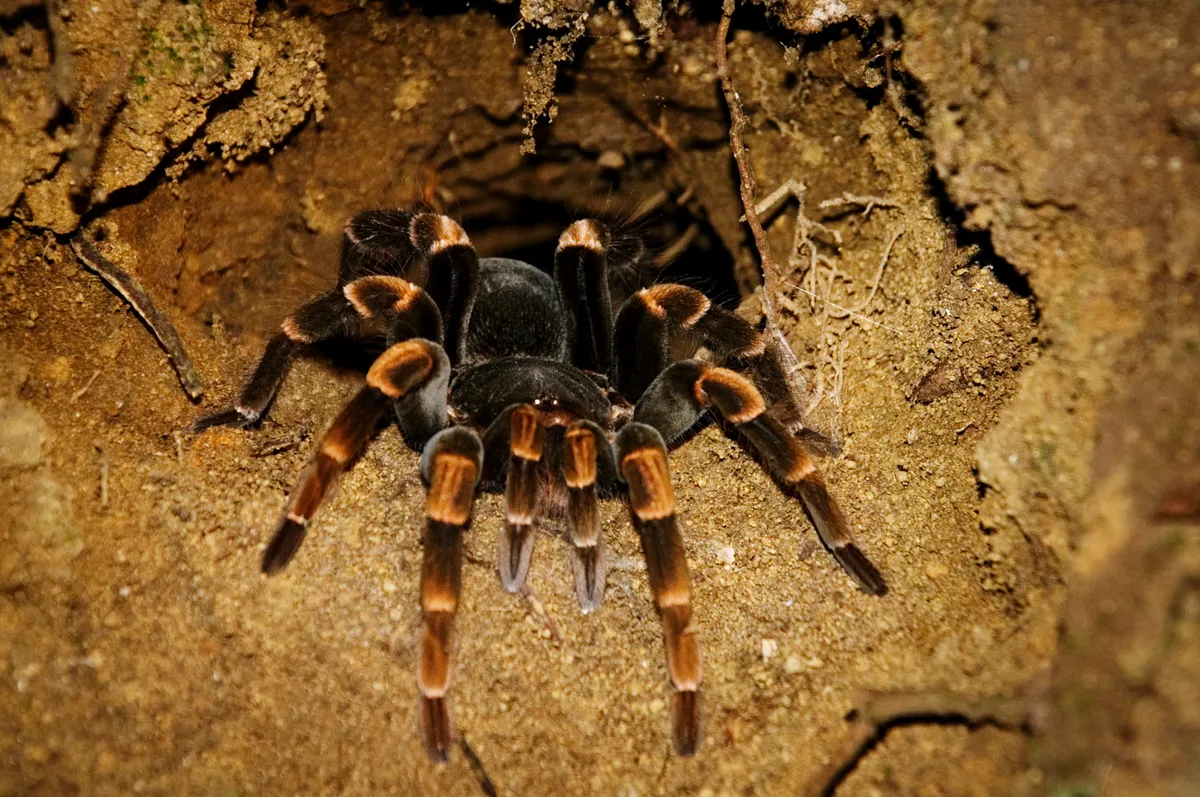Tarantulas – more accurately called theraphosids – are large spiders with a fearsome reputation. Danniella Sherwood from the Natural History Museum explains all you need to about these much maligned spiders
What are tarantulas?
Confusingly, the name tarantula originally referred to the wolf spider (Lycosa tarantula), which belongs to an entirely different family. It was thought that its bite could only be survived by performing a dance called the tarantella. However, in popular culture, the name tarantula is nowadays almost synonymous with theraphosids.
Why are tarantulas so feared?
Predominantly due to their large size, but also the long-held belief that their venom can be fatal to humans. While some species can produce medical symptoms in humans, no evidence of fatalities from theraphosid bites has ever been recorded.
How many species of tarantulas are there?
There are currently more than 1,000 species of theraphosid recognised, with further species being discovered every year.
What’s the biggest tarantula?
The largest species belong to the genus Theraphosa, all of which can reach a whopping leg-span of at least 23-28cm, though there’s a debate as to which has the widest. The largest bodyweight record is currently held by Theraphosa blondi, alarmingly known as the Goliath bird-eater. It also holds the title of the biggest spider in the world.
At the other end of the spectrum, some tarantulas are surprisingly small. An adult Trinidad dwarf tarantula (Cyriocosmus elegans) is less than 5cm, for instance.
Why are tarantulas so hairy?
Hairiness is just a general characteristic that evolved in theraphosids. However, members of a subfamily called Theraphosinae possess special stinging hairs called urticating setae. These are located on the abdomen and act as a defence mechanism.
More fascinating spider facts
- Scariest spiders: 8 arachnids that may give some people the creeps
- World's most venomous spiders: Are these deadly spiders as fearsome as their reputation?
- 5 of the biggest spiders in the UK: look for them in canals, gardens, ditches... and under your bed
- 14 incredible spider facts you probably didn't know
Where do tarantulas live?
Tarantulas are found on all continents except Antarctica, though the most diverse range of species lives in the Americas, Africa and Asia. There are a handful of species in Europe, restricted to hot areas in the south of the Mediterranean.
How many eyes does a tarantula have?
Almost all tarantulas have eight eyes, though they are not much use except for determining light and dark, or making out large shapes. However, a few dozen species live in caves and have, amazingly, adapted to their environment to such a degree that they do not need eyes anymore – they’re totally blind in the traditional sense. Instead, they rely on trichobothria (special sensory hairs on the legs of all tarantulas) to interpret and sense the world.
Do they spin webs?
Not the classic circular spider’s web you might be used to seeing, but they do produce web, which is used to make silken retreats under stones and logs, or in trees.
Many theraphosids also live in burrows, and they line the entrance with web to help detect prey and ensure the burrow doesn’t collapse in on itself. The burrows can be ones they’ve dug themselves, or they sometimes occupy burrows already dug, and subsequently abandoned, by larger animals (including invertebrates).
Why are their webs different from the ones we are used to seeing?
Theraphosids belong to Mygalomorphae, which is a more primitive suborder than Araneomorphae – the one that includes classic species that people see in their gardens, such as orb web and sheet web spiders. The familiar constructions of Araneomorphae, such as orb webs and sheet webs, evolved much more recently and only within the lineage of this suborder. Theraphosids were around millions of years before and their hunting strategies were already very effective – evidently they didn’t suffer selection pressure to change them.
How do tarantulas hunt?

They are sit-and-wait predators. They will sit at the entrance of their retreat or burrow and wait for prey to come past onto the web surrounding the entrance, before catching it and bringing it inside to eat.
What do tarantulas eat?
Theraphosids typically eat invertebrate prey. However, they can also eat vertebrate prey, including snakes, lizards, frogs, rodents and even small birds. They will cannibalise on occasion, too.
Do tarantulas have any predators?
Tarantulas are occasionally eaten by reptiles, small mammals, scorpions and centipedes. In some countries, such as Cambodia, they are even on the menu for humans, which might threaten wild populations. Remarkably, there’s a family of wasps called Pompilidae that hunt spiders – some giant species have evolved to attack tarantulas and hunt them ruthlessly.
What threats do they face?
The most pressing threats to tarantulas are probably the same ones faced by millions of other species of invertebrates and vertebrates: increasing habitat destruction and the critical threat of climate change. There are a number of tarantula species now likely to be extinct due to complete destruction of their highly specialised and restricted habitat.
Danniella Sherwood is a voluntary assistant curator of arachnida at the Natural History Museum, London, a research associate of the Arachnology Research Association.
Main image: Mexican red knee tarantula © Getty Images